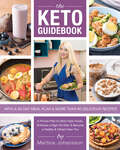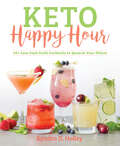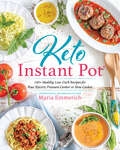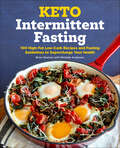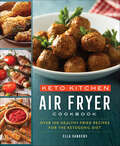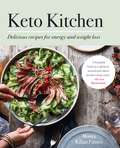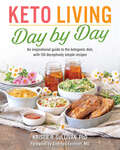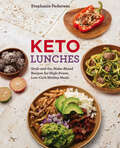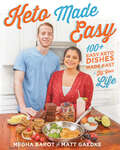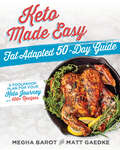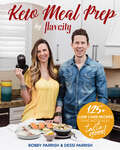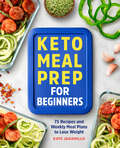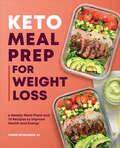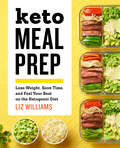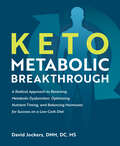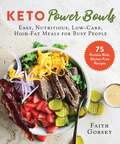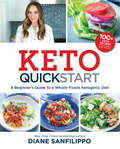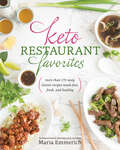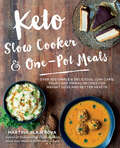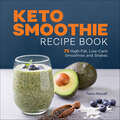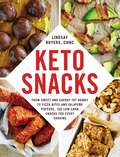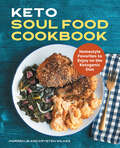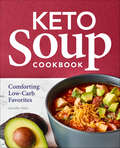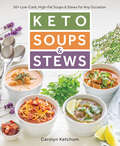- Table View
- List View
Keto Guidebook
by Martina JohanssonA lot of people out there are starting to hear about the ketogenic diet but aren’t sure what all the fuss is about. Others have heard a lot but still don’t trust that it’s healthy. And still others have even tried it but found that it didn’t work especially well for them. Swedish bioengineer, fitness athlete, and keto expert Martina Johansson has the unique ability to explain complex biochemistry in an accessible and captivating manner to help readers understand why the keto diet actually works and is healthy if followed correctly and tailored to one’s individual needs. The Keto Guidebook provides the keys to: * LOSING WEIGHT * LOOKING YOUTHFUL AND RADIANT * FINDING NEW ENERGY * STAYING FIT OR IMPROVING HEALTH This book offers a wealth of practical tools to achieve all this and more, along with lists and charts of keto-approved foods, 90 recipes, and a solid 4-week meal plan to make the transition to ketogenic eating simple and delicious. Martina also shares her in-depth knowledge of hormonal responses, as well as the health effects and benefits of different types of micro- and macronutrients—two hot-button topics that are critical to understand for keto success.
Keto Happy Hour
by Kyndra HolleyListen up, low-carb libation lovers! Kyndra Holley, the evil genius behind the popular food blog Peace, Love and Low Carb, is at it again with her new book, Keto Happy Hour: 50+ Low-Carb Craft Cocktails to Quench Your Thirst. Readers rely on Kyndra for healthy, keto-friendly versions of their favorite carb-laden foods. With this book, she shows you how to up your cocktail game, too. Kyndra knows that navigating alcohol can be tricky on a low-carb diet, so she takes all the guesswork out of it for you, showing you how to indulge while sticking to a healthy ketogenic lifestyle. Think you can no longer enjoy a refreshing Moscow Mule at happy hour with your friends, or that you have to skip the margaritas on Taco Tuesday? Think again! Keto Happy Hour puts your favorite drinks back on the menu—the low-carb menu, that is. Whether you are craving a cocktail after a long day at work or looking to entertain guests, this book has you covered. From mixers to drinks and even some pub grub, it’s all here! Mixing up cocktails should be fun, and it shouldn’t come at the cost of your health and weight-loss goals. Keto Happy Hour bridges the gap between feeling deprived and feeling mighty fine. With recipes like these—and even Strawberry Margarita Gummy Worms!—there is something in this book for everyone. •Strawberry Basil Lemon Drops •Dill Pickle Martinis •Cucumber Mojitos •Moscow Mules •Frosted Rum Cakes •Lemon Basil Crush Happy hour starts now!
Keto Instant Pot
by Maria EmmerichThe Instant Pot is one of the hottest cooking tools around these days. With its ability to pressure-cook foods in mere minutes, all in one pot, it is a huge time-saver for busy home cooks. You can even bake a cheesecake in it! A ketogenic diet that eliminates processed foods sometimes require a little more effort in the kitchen, so any time saved is a plus. In this book, international bestselling author Maria Emmerich presents more than 160 delicious low-carb, high-fat keto recipes designed to be cooked in an Instant Pot or other multi-cooker. The recipes run the gamut from appetizers and sides to soups to main dishes to sweet treats and even a few drinks, along with some handy keto basics. As a bonus, Maria also includes slow-cooking instructions (which can be done either in the Instant Pot or in a separate slow cooker) for each recipe for those days when set-it-and-forget-it convenience takes precedence over the need for speed. Recipes include: Pumpkin Coffee Cake Easy Baked Eggs Buffalo Meatballs Crab-Stuffed Mushrooms Italian Chicken Chili Curry Beef Stew Philly Cheesesteak Pork Lettuce Cups Amazing Asian Pulled Pork Chicken and Bacon Lasagna Roll-ups Garlicky Tuna Casserole Lemon Ricotta Torte Chocolate Almond Fudge Homemade Root Beer ...and much more! You’ll also find tips for success, along with Maria’s recommendations for Instant Pot extras to consider purchasing to make keto cooking easier. So what are you waiting for? Add this handy kitchen appliance to your low-carb cooking arsenal and put it to good use for tasty and healthy keto meals!
Keto Intermittent Fasting: 100 High-Fat Low-Carb Recipes and Fasting Guidelines to Supercharge Your Health
by Michelle Anderson Brian StantonKeto and intermittent fasting—a supercharged one-two punch for your healthKeto and intermittent fasting are two of the most popular nutritional programs around, and together, they form a powerful high-fat, low-carb, pound-shedding team. Both get you running on fat. Both get you making ketones. And when combined, they propel you into fat-burning mode faster than either alone.Filled with 100 keto recipes like Chicken Avocado Omelet and Portobello Mushroom Margherita Pizza, Keto Intermittent Fasting includes delicious recipes tailored to a fasting lifestyle. You'll see numerous health benefits including weight loss, stable energy, and improved gut health. Prepare your body and mind for the journey with tips for success and navigating the most common side effects, as you unleash your inner fat combustion engine.Inside Keto Intermittent Fasting, you'll find:Start strong—Get a 7-day meal plan for each Keto intermittent fasting regimen, whether you are starting with a daily fast or weekly fast strategy.Prepare your pantry—Discover a list of foods to love, to eat in moderation, and to eliminate.Powerful knowledge—Dive into the science behind how keto and intermittent fasting work together.If you have struggled with results in the past or are looking for a diet that works, consider Keto Intermittent Fasting. Calorie counting alone isn't the key to weight loss—keeping blood sugar and insulin low is.
Keto Junk Food: 100 Low-Carb Recipes for the Foods You Crave—Minus the Ingredients You Don't!
by Faith Gorsky Lara ClevengerHave your cake…and stay keto too with this low-carb cookbook featuring 100 recipes for keto-friendly junk foods like pizza, milkshakes, and more.Think going keto means giving up your favorite snacks? Think again! Now you can have the munchies you crave minus the ingredients you don&’t. Whether you&’re looking for something sweet or savory, you&’ll find exactly what you&’re looking for in Keto Junk Food with 100 delicious and low-carb recipes like: -Cheesy, pepperoni-filled pizza logs -Fresh donuts -Savory stuffed pretzels -Homemade milkshakes -And more! Whether it&’s a sweet treat or a savory snack, Keto Junk Food lets you indulge in the delicious, junky side of keto-friendly cooking so you never miss out on the foods you love
Keto Kitchen Air Fryer Cookbook: More Than 100 Healthy Fried Recipes for the Ketogenic Diet
by Ella SandersIndulge in your favorite fried foods while losing weight! Going keto just got delicious! The secret to getting amazing results while following a ketogenic diet is taking in just the right amount of carbs and healthy fats to keep your metabolism revving and your appetite satisfied. That’s why your best tool for hitting keto goals is an air fryer! The super-versatile yet compact appliance puts you in complete control with flavorful, fried foods that keep your carb and fat intakes in perfect keto range. Ella Sanders's Keto Kitchen: Air Fryer Cookbook gives you more than100 recipes that deliver big on luscious taste and keto weight loss, including:· Bacon, Cheese & Avocado Melt· Southern Fried Drumsticks· Chicken Croquettes with Creole Sauce· Crispy Pork Chops· Poblano Pepper Cheeseburgers· Chicken Fried Steak with Cream Gravy· Thai Pork Meatballs· Crab Cakes with Lemon Aioli· Broccoli-Cheese Fritters· Keto Mozzarella Sticks· Fried Cheesecake Bites· Air-Fried Doughnut BitesFrom breakfast through dessert (and snacks in between), you’ll find tasty choices with simple step-by-step instructions and complete nutrition information to help you meet your keto and weight-loss goals!
Keto Kitchen: Delicious recipes for energy and weight loss (Keto Kitchen Ser.)
by Monya Kilian PalmerFollowing a low-carb, high-fat ketogenic diet helps you lose weight, feel great and enjoy better energy and mental clarity. More and more people are turning to this healthy and delicious way of eating, but with lots of information about macronutrients and ketosis, it can be hard to know where to begin. Keto Kitchen makes it easy, with simple, delicious and inspiring recipes that fit into your busy lifestyle.This fantastic collection of recipes has been created by talented chef and keto devotee Monya Kilian Palmer. From Brown-Butter Scrambled Eggs to Slow-cooked Lamb Shoulder with Roast Cherry Tomatoes, every recipe is packed with flavour and nutrients. There are even desserts, including a Dark Chocolate and Raspberry Tart and Lime Cheesecake. The dishes are rich, indulgent and tasty. This is not diet food as you know it.Monya Kilian Palmer is a chef and culinary consultant originally from Cape Town, South Africa. Since moving to the UK in 2012, she has worked for both Heston Blumenthal's Fat Duck Group and Le Cordon Bleu. She has been following the ketogenic lifestyle since mid-2018.
Keto Living Day By Day
by Kristie SullivanIn her new book, Keto Living Day by Day, Kristie Sullivan brings you along on her inspiring journey to health and happiness through adopting a low-carb, high-fat lifestyle. She shares the failures she experienced when using today’s overly prescribed high-carb, low-fat (and also sugar-laden) diets and details how the ketogenic diet helped her lose more than 100 pounds! Kristie hopes that her story will inspire you to take charge of your own life and find your unique path to wellness. With her approachable and sensible philosophy and techniques, you too can use the keto template to overcome challenges, develop a truly healthy mindset, and shed unwanted pounds. Keto Living Day by Day will help you banish your fear of eating fat and embrace a scientifically proven and highly effective nutritional path. Keto Living Day by Day offers a real-world approach to low-carb/keto dieting. Kristie walks you through every step, starting with a simple and easy-to-understand breakdown of the nutritional science behind keto. She provides examples to match many of the scenarios that people encounter when starting a ketogenic diet and offers solutions for each, enabling you to find the most successful path for your needs. Section two of the book features a daily guide to help you make the keto way your way. Starting on day 1, Kristie shows you how to understand the challenges involved in making the transition, navigate around obstacles, and track your progress. She also offers tips for staying on course in social settings and when dining out, as well as foolproof ways to face down temptations. In addition, Keto Living Day by Day features a detailed preparation guide that includes advice on stocking your pantry with keto essentials and a day-by-day guide to implementing a ketogenic lifestyle. For maximum success, Kristie brings you her best tips for meal planning and preparation along with budget-friendly shopping guidelines. Keto Living Day by Day concludes with more than 130 easy-to-love keto recipes that Kristie has used to nourish herself, her family, and her friends. These recipes are easy to follow and are designed for people who enjoy mouthwatering meals but want to minimize time spent in the kitchen. The ingredients used in the recipes are readily available; most can be found at your local grocery store. Sample recipes include: Breakfast Pizza Broccoli Cheddar Ranch Chicken Soup Savory Ribs Lemon Chicken Moo Goo Gai Pan Pepper Steak Swedish Meatballs in Gravy Vanilla Coffee Creamer Mocha Latte Creamy Vanilla Ice Cream Keto Living Day by Day not only details Kristie’s inspiring journey, but also shows you how you can learn from her experience and use the keto template to lose weight and rediscover health.
Keto Lunches: Grab-and-Go, Make-Ahead Recipes for High-Power, Low-Carb Midday Meals
by Stephanie PedersenSticking to your keto diet just got easier (and more delicious) thanks to these easy grab-and-go lunches! Keto eating is one of today&’s hottest trends—but lunch can be especially challenging for those on this popular diet. What should you prepare? And how can you find time to make it? Fortunately, this cookbook has you covered with more than 100 simple, quick recipes, from twists on traditional lunches like wraps, sandwiches, and pizzas to grain bowls, stir-fries, curries, and yummy snacks to keep your energy high. There are even vegan variations for many of the recipes, and all the dishes are perfect for anyone on a high-fat, low-carb diet—including Atkins, South Beach, and Paleo. Renowned food writer and nutritionist Stephanie Pedersen also provides advice on outfitting your kitchen for success, stocking your fridge, and the building blocks for meal-prepping a host of fantastic keto-approved lunches.
Keto Made Easy
by Megha BarotEverything can be made keto! That’s the message that food bloggers Matt Gaedke and Megha Barot want to deliver with their new book, Keto Made Easy. No more missing out on classics or favorite dishes, no more added costs with exotic new ingredients—in Keto Made Easy, Matt and Megha show you how to re-create non-keto recipes in easy, cost-effective, and delicious ways. Recipes include: • Crab Mac ’n’ Cheese • Fish Tacos • Chicken Alfredo • Hush Puppies • Chocolate Chip Cookies • Navajo Fry Bread • Gyros • Skillet Pizza • Yellow Curry Keto Made Easy is on a mission to demonstrate to readers that every meal can be low-carb, satisfying, and great for the whole family.
Keto Made Easy: Fat Adapted 50 Day Guide
by Megha BardotYou already know you want to eat healthy and start burning fat. But making that happen on a daily basis can feel time-consuming and difficult—it’s hard to know where to start. Megha Barot and Matt Gaedke from KetoConnect are here to change that. Their guide to adopting a nutritious low-carb, fat-burning keto lifestyle is a complete step-by-step road map for fifty days of keto. In this book, you will learn: The easiest way to make sure you’re getting the right assortment of carbs, proteins, and fats What to expect as your body begins to burn fat for fuel instead of sugar How to snack the keto way How to find keto-friendly takeout, so you don’t have to cook everything from scratch How to turn one dish into multiple dinners throughout the week The meal plan takes the guesswork out of cooking—no more of that dreaded question, “What’s for dinner?”—and incorporates weekly meal prep so that you spend as little time as possible in the kitchen. And with recipes like Zucchini Basil Muffins, Mustard-Rubbed Pork Tenderloin, and Peanut Butter Cookies, you’ll look forward to mealtime! Keto Made Easy: Fat Adapted 50-Day Guide gives you the knowledge and tools for fat-burning keto success.
Keto Meal Prep by FlavCity: 125+ Low Carb Recipes That Actually Taste Good (Flavcity Ser.)
by Bobby Parrish Dessi ParrishThe creators of FlavCity shares the secrets to making seven days of healthy and delicious meals in one evening with easy, creative meal prep recipes. With over one million fans, FlavCity is the go-to spot for keto diet recipes that help you lose weight without sacrificing the joy of delicious food. In Keto Meal Prep, Bobby and Dessi Parrish show you how to maximize your time—and maintain your ketogenic diet—by preparing seven days of healthy meals in one evening. This book includes fifty low-carb keto meal prep recipes, each containing two or three components you can mix and match to create more than 125 delicious combinations. These easy-to-follow recipes are designed to be prepped in advance, so when you&’re tired and hungry, a healthy meal is just minutes away. Enjoy recipes for protein-filled breakfasts, exciting lunches, crave-worthy dinners, tasty snacks, keto desserts!Keto Meal Prep by FlavCity includes: Fifty keto meal prep recipes, each containing two to three components Twenty-five individual keto-approved recipes Detailed macros and carb count for each recipe Allergen index for nuts, dairy, and eggs for each recipe, and with Paleo designation Video tutorials that are live on YouTube Tips for becoming a meal prep boss Actual fan reviews and more!
Keto Meal Prep for Beginners: 75 Recipes and Weekly Meal Plans to Lose Weight
by Kate JaramilloPrep your meals in advance to make keeping keto easy Sticking to a ketogenic diet can sometimes feel like a chore, but there is a way to simplify your life and still experience all of keto's awesome benefits: meal prepping. This beginner-friendly keto cookbook makes the whole process easier with streamlined guidance and delicious, no-fuss recipes. Burn fat and fuel your brain with a complete plan that helps you stay keto for the long term! What sets this keto diet cookbook apart from other keto meal prep cookbooks for beginners: Keto meal prep basics—Learn the steps to becoming a meal plan master and why keto-friendly foods are perfect for prepping. 6 weeks of meal plans—Take the guesswork out of meal prepping with straightforward guides, shopping lists, and step-by-step instructions. Quick keto recipes—Live a fat-fueled lifestyle for breakfast, lunch, and dinner (plus snacks) with mouthwatering dishes that feature familiar, budget-friendly ingredients. Maintaining your keto diet is simpler than ever with Keto Meal Prep for Beginners.
Keto Meal Prep for Weight Loss: 6 Weekly Meal Plans and 70 Recipes to Improve Health and Energy
by Emmie Satrazemis RDMeal prep for success on the keto diet The low-carb, high-fat ketogenic diet is a proven way to stay energized and sustain weight loss—but cooking balanced keto dishes every day can be a major chore. That's where meal prep comes in! This keto cookbook walks you through 6 full weeks of pre-planned meals that you can make and store in advance, so you'll always have tasty, healthy options ready to eat. Discover a keto meal prep cookbook for beginners that helps you: Get started—Find a quick intro to the keto diet and what makes it great for losing weight—then see how simple it is to meal prep a keto menu. Prep like a pro—Take the guesswork out of what to eat next with detailed meal plans complete with shopping lists and step-by-step instructions. Stay on track—Get accurate macronutrient counts on every recipe and feel confident you're meeting your health goals. Fit the keto diet into your busy lifestyle with the ultimate guide to planning meals ahead of time.
Keto Meal Prep: Lose Weight, Save Time, and Feel Your Best on the Ketogenic Diet
by Liz WilliamsKeep it keto with this guide to pre-made weeknight meals that are always ready to goA little planning and prepping go a long way toward success on the ketogenic diet. In Keto Meal Prep, you'll make healthy, homemade keto meals a regular part of your routine with tips, lists, and instructions for preparing your meals in advance.This keto guide sets you up for success on the ketogenic diet with:Weeknight meals, ready to serve—With your meals organized and ready five days a week, sticking to a keto diet is easier than ever.Keto meal prep 101—Get a crash course on the best practices for meal prep, including batch cooking, storage tips, and finding the right schedule for you.Three meal-plan sections—Work through 10 days of meal prep for each type of plan: beginners, those who work out regularly, and longer-term keto eaters looking to maintain results.Get the keto diet book that keeps it simple with a straightforward plan for weekly meals from the ultimate keto meal prep book.
Keto Metabolic Breakthrough
by David JockersIn his new book, The Ketogenic Metabolic Breakthrough, Dr. David Jockers delivers a revolutionary new approach to transforming your health by using the principles of the ketogenic diet to reset your metabolism. Chronic illness, degenerative disease and obesity often appears as a direct result of metabolic dysfunction. Using the principles of the low-carb, high-fat ketogenic diet, Jockers will show you how remedy these health problems on finite level by changing your metabolic state. Throughout his book, Dr. Jockers brings you a wealth of expertise, and walks you through step-by-step how to begin and sustain a ketogenic diet. He also highlights and debunks the most common myths circulating about the keto diet and offers the real science behind this nutritional plan that - with the right approach - can forever change your life! This book is also designed to help people trouble shoot common challenges they may experience as they go through the process of keto adaptation so they know what to expect and what to do if they are struggling through this phase. Jockers also incorporates best practices for how to transition from the standard American diet and into the keto diet and lifestyle in a way that is gentle on the body and provides exceptional resources for how to shop, set up refrigerator and pantry and meal plan to ensure success!
Keto Power Bowls: Easy, Nutritious, Low-Carb, High-Fat Meals for Busy People
by Faith GorskyEat Your Way to Health with 75 Quick and Easy and Gluten-Free LCHF Recipes for Busy People on a Keto Diet Keto power bowls are the perfect way to pack a ton of nutrition into a single balanced meal for busy individuals and families on a keto diet! High-quality proteins, healthy fats, and non-starchy fruits and vegetables are the base of these customizable bowls. Use bases like zucchini noodles, cauliflower rice, and stir-fry, and add a protein, flavorful sauce, and nutrient-dense sides for one-bowl meals that are satisfying, easy to whip up (and can be made ahead of time), budget-friendly, and crowd-pleasing! Featuring 75 easy-to-follow ketogenic recipes (that are also gluten-free and grain-free with no added sugar), Keto Power Bowls is for everyone—busy parents cooking for their families, singles who pack a healthy lunch for work, people who are trying to bulk up in the gym, and anyone who is short on time but doesn't want to sacrifice health. Learn to make breakfast, dinner, salad, soup, and desert bowls, as well as components like sauces and sides, with a variety of international flavors and dairy- and nut-free options: Poached Eggs with Pan-Fried Summer Squash Turkey Sausage Breakfast HashSweet and Sour Chicken Stir FryRosemary Lamb Greek Meatballs with Creamy Cucumber Salad and FetaChipotle Lime Shrimp Cauliflower Rice BowlsClassic Taco Salad BowlsThai Coconut Curry BowlsKiwi Raspberry Smoothie BowlsAnd More! Including information on how to meal prep power bowls, what a balanced meal looks like on a low-carb diet, how to swap out components to create new flavor profiles, and how to use power bowls to achieve different health goals (weight maintenance, weight loss, and weight gain), Keto Power Bowls is your ultimate guide for keto cooking and eating that will help you meet your macros.
Keto Quick Start: A Beginner's Guide To A Whole-foods Ketogenic Diet With More Than 100 Recipes
by Diane SanfilippoNew York Times bestselling author and health and wellness pioneer Diane Sanfilippo brings her own experience with a ketogenic diet to Keto Quick Start, a comprehensive and easy-to-follow road map to transitioning to a keto lifestyle. There’s a good reason keto has attracted so many followers: it’s an effective tool for fat loss as well as a way of eating with proven benefits for many health concerns, including unstable blood sugar, neurological conditions, and epilepsy, to name a few. But getting started with keto and sticking with it can be tough. That’s where Keto Quick Start comes in. In her signature practical style, Diane makes keto doable for everyone, whether you’re completely new to very low carb eating or you’ve tried it before and want to find a better way to make it work for you. Keeping the focus on real foods that nourish your body, she walks you through a gentle transition to keto and helps you figure out how to make it sustainable for the long term. Keto Quick Start targets everyday real-world concerns such as what to expect in the first few weeks and how to know if you’re on the right track, how to determine if you need more carbs and how to incorporate those carbs in a healthy way, how to customize keto for your personal goals (especially weight loss), and things to be aware of if you’re concerned about a particular health issue. Keto Quick Start includes 100 delicious keto recipes, four weekly meal plans, more than a dozen easy meal ideas (no recipe required!), and troubleshooting tips and tricks. It also features a unique and easy-to-use template that makes tracking your food quick and simple. The recipes include: - Lemon Blueberry Keto Muffins - Kale, Bacon & Goat Cheese Frittata - Spaghetti Bolognese Bake - Powered-Up Bacon Cheeseburger - Shrimp Pad Thai - Pesto-Stuffed Mushrooms - Chocolate Orange Fudge - Creamy Peanut Butter Bites
Keto Restaurant Favorites
by Maria EmmerichThe ketogenic diet has taken the world by storm, and deservedly so: its results in helping people lose weight, manage chronic health conditions, and simply feel great are unmatched. Bestselling cookbook author Maria Emmerich sits at the forefront of the keto movement and has become the go-to source for high-fat, low-carb recipes that both please the palate and nourish the body. With Keto Restaurant Favorites, Maria delivers once again by putting a new and unprecedented twist on ketogenic cooking. Eating keto doesn’t mean that you have to give up the dishes you love! Instead, Maria shows you how to re-create those recipes, keto-style. Keto Restaurant Favorites answers the demand for a one-stop cookbook that allows you to easily replicate your favorite restaurant cuisine in your own kitchen. Maria’s recipes masterfully mimic the dishes you love using healthy, readily accessible ingredients. In addition to classic American fare, this book offers recipes for a variety of cuisines, including Italian, Chinese, Mexican, and Thai. Maria even includes favorites from the kids’ menu! Recipes include: • Bacon cheeseburger • Copycat Frosty • Corn dogs • Curry • Pho • Tom ka gai • Carne asada • Gnocchi • Calzones • Cannoli • General Tso’s • And many more! With nearly 170 recipes covering a broad spectrum of restaurant cuisine, Keto Restaurant Favorites is sure to please even the pickiest eaters. Say goodbye to feeling deprived! This book gives you all the tools you need to re-create your favorite dine-in and takeout offerings in a healthy and delicious ketogenic way.
Keto Slow Cooker & One-Pot Meals: Over 100 Simple & Delicious Low-Carb, Paleo and Primal Recipes for Weight Loss and Better Health (Keto For Your Life Ser. #4)
by Martina SlajerovaWith this collection of one hundred high-fat, low-carb ketogenic recipes, enjoy quick, tasty dinners as you get healthy, lose weight, and control your blood sugar.The ketogenic diet is regarded as a go-to eating plan for losing weight, reversing certain illnesses—such as diabetes—and even maintain general health. However, living ketogenic can be time-consuming and complicated. Slow-cooker and one-pot meals are the ultimate convenience food. Just fix and forget, then enjoy a nourishing meal when everyone gets home.Unfortunately, most slow-cooker and one-pot recipes depend on processed, high-carbohydrate ingredients such as noodles, potatoes, and other high-glycemic staples that aren’t allowed on the ketogenic diet.Keto Slow Cooker & One-Pot Meals lets you enjoy your slow cooker while maintaining your ketogenic diet, too! Filled with over one hundred keto recipes for everything from satisfying soups to quick skillet meals and savory stews, you’ll always be able to get a healthy ketogenic meal on the table with no fuss!Enjoy nourishing meals that are comforting and good for you like:Chicken Mulligatawny SoupMushroom & Dill Sour SoupPumpkin & Chorizo Meatball SoupItalian Sausage FrittataCrispy Chicken with Olives and LemonCoq Au VinThai Pork Lettuce CupsCheesy Cauliflower CasseroleChicken Tikka MasalaFestive Turkey MeatballsBeef BourguignonOsso Bucco with GremolataSpiced Chocolate & Coconut CakeCarrot Cake OatmealMacadamia Chai CakeBrownie Almond Cheesecake BarsPraise for Keto Slow Cooker & One-Pot Meals“Simply designed with a gorgeous layout, this book is a winner! I’m really impressed with the tools and tips offered throughout the book—it’s great for slow cooking newbies and veterans alike!” —Leanne Vogel, bestselling author of the Keto Diet
Keto Smoothie Recipe Book: 75 High-Fat, Low-Carb Smoothies and Shakes
by Tasha MetcalfDrink your way to ketosis Going keto doesn't mean giving up the satisfaction or convenience of smoothies. These rich and flavorful recipes toss out traditional ingredients like milk and sugary fruits, offering enjoyable alternatives that will help you keep your carbs low and achieve your health goals.What sets this healthy smoothie recipe book apart:Keto smoothies explained—Learn all about the science of smoothies and how they can become an important cornerstone of a successful keto diet.75 tasty recipes—From Chocolate Hazelnut to Virgin Bloody Mary, discover a full range of ketofied recipes—complete with plenty of mouthwatering photos—that are sure to satisfy.Clear carb counts—Each smoothie lists its total carb count right at the top of the page, making it easy to find the options that will fit into your day.Beginner-friendly options—New to the keto diet? Choose from a selection of hydrating and restorative recipes designed to help fight the "keto flu" and keep you feeling your best.Keep smoothies on the menu with this standout smoothie cookbook.
Keto Snacks: From Sweet and Savory Fat Bombs to Pizza Bites and Jalapeño Poppers, 100 Low-Carb Snacks for Every Craving (Keto)
by Lindsay BoyersStick to your keto diet without giving up your favorite foods with these 100 easy-to-make high fat, low-carb snacks. Starting a ketogenic diet—high in fat, low in carbs—doesn’t mean giving up on all your favorite snacks! Instead of eating foods that might prevent you from entering ketosis, you’ll need options that will help your body burn fats instead of carbs. You’ll find just what you need in Keto Snacks, featuring 100 easy, delicious recipes for sweet and savory low-carb treats. Learn to make “fat bombs”—small energy-filled snacks with low carbs and high fat, like Pizza Balls or Sunbutter Balls. Try other savory keto snacks like deviled eggs or guacamole, or go sweet with some chocolate mousse for dessert! In Keto Snacks, you’ll find yummy recipes for Creamy Rosemary and Prosciutto Baked Avocado, Chorizo-Stuffed Jalapenos, Coconut Almond Truffles, Peanut Butter Cup Cheesecake—and much more! You’ll be sure to find a tasty keto snack to satisfy any craving, any time of day!
Keto Soul Food Cookbook: Homestyle Favorites to Enjoy on the Ketogenic Diet
by Marrekus Wilkes Krysten WilkesMake healthy, keto-friendly versions of your favorite soul foods Soul food is a delicious cuisine rich in culture and history, and now you can enjoy it even if you're sticking to a ketogenic diet! Whether you eat keto full time or simply want to put a healthier twist on the dishes you know and love, The Keto Soul Food Cookbook is filled with simple low-carb recipes designed with the soul food enthusiast in mind. Every recipe stays true to the traditional cooking methods, flavors, and textures of the soul food you crave while minimizing sugar and carbohydrates to help you maintain ketosis. The Keto Soul Food Cookbook includes: An intro to keto cooking—Learn how the ketogenic diet works, how to adapt classic soul food dishes to be keto-friendly, and how to stock your kitchen with the essentials. Simple ingredients—No need to shop at specialty stores for these recipes! You can find everything in this soul food cookbook easily and affordably at your local grocery store. A focus on nutrition—Find nutritional calculations with each recipe so it's easy to choose meals that align with your health goals. Cook up keto dishes with soul, with help from The Keto Soul Food Cookbook.
Keto Soup Cookbook: Comforting Low-Carb Favorites
by Jennifer AllenCreate keto soups that minimize carbs and maximize flavor There's nothing more comforting than a good bowl of soup. Finding keto versions of your favorites can be challenging, but you can now put soups back on the menu with the best soup cookbook for keto. Discover delicious recipes with simple, ketogenic-friendly ingredients and easy instructions that range from homestyle classics to creative new flavor combos.What sets this book apart from other soup cookbooks:60 different soups—From creamy vegetable soups to hearty meat and noodle stews, this book has traditional recipes with a keto twist, and new favorites like Salmon and Zucchini Chowder and Butternut Squash Soup with Turmeric and Ginger.A keto cooking guide—Learn the techniques for making any soup keto, and get the know-how you need to make the perfect bowl every time.Souped-up sides—Complement your favorite recipes with delectable keto crackers and breads, including olive focaccia and jalapeno cheese bread.Turn classic stews, chowders, and more into scrumptious, carb-reduced creations with the Keto Soup Cookbook.
Keto Soups & Stews
by Carolyn KetchumIs there anything better than wrapping your hands around a steaming bowl of soup on a chilly day? Soups and stews are the epitome of comfort food, literally warming us up from the inside out. They are also simple and economical to prepare, and they’re easy to store away for quick lunches or dinners when there’s no time to cook. Carolyn Ketchum knows how to pack her recipes with layers of flavor as well as nutrients, without adding a lot of carbs. In this book, you’ll find recipes for hearty and filling soups and stews as well as lighter, more refreshing fare—plus a few keto breads for sopping up every last drop. Along with three recipes for broth, the book features recipes such as: •Chicken Avocado Lime Soup •Instant Pot Chipotle Beef Stew •Steak & Bacon Chili •Chinese Pork & Cabbage Soup •Nourishing Breakfast Soup •Lobster Bisque •Dairy-Free Clam Chowder •Curried Pumpkin Soup •Strawberry Basil Soup •Garlic Parmesan Breadsticks The recipes are marked with handy icons that tell you at a glance which ones are vegetarian, freezer-friendly, quick and easy, and more. In many cases, Carolyn provides options for multiple cooking methods, including the popular Instant Pot. You’ll also find handy tips for stocking your kitchen, making keto swaps for higher-carb ingredients, putting together a good soup or stew, and storing and reheating your creations. So grab a pot, a ladle, and some bowls and get cooking!
